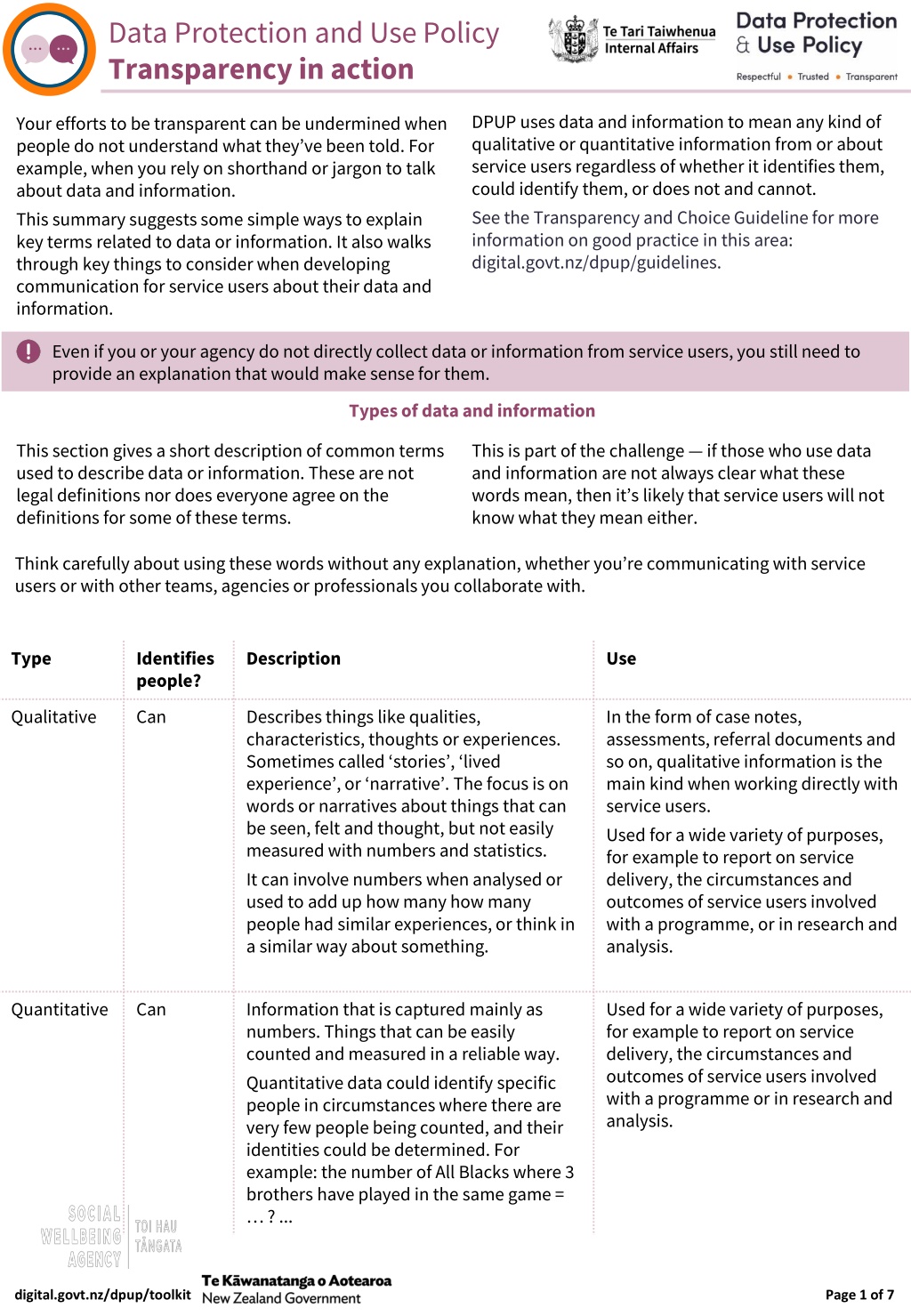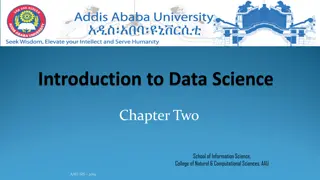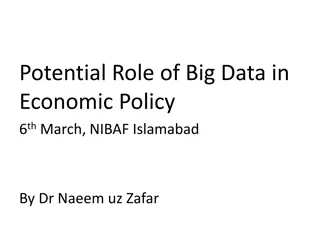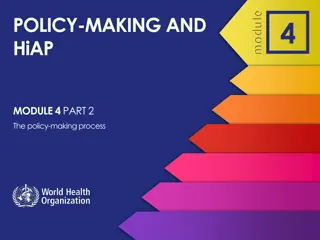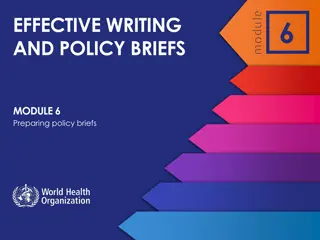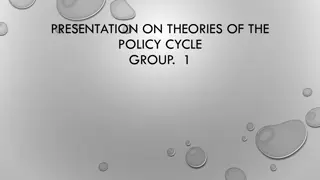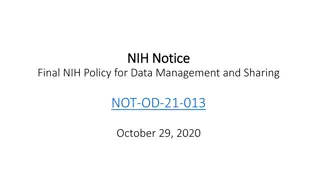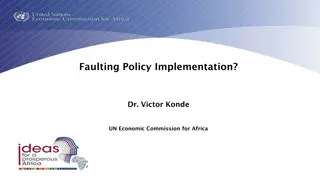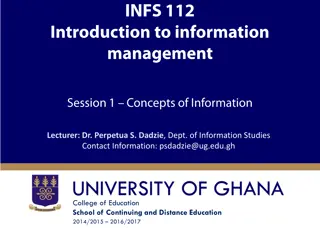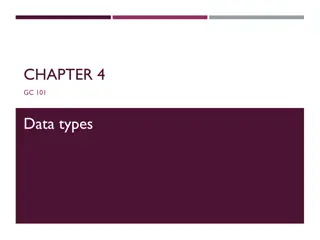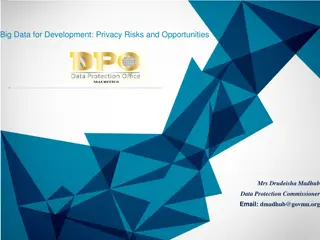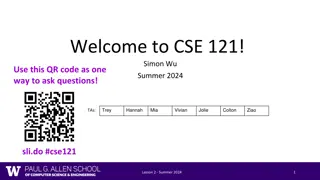Understanding Data and Information Types in DPUP Policy
DPUP's Data Protection and Use Policy emphasizes transparency in utilizing both qualitative and quantitative data to describe service users. The provided guidelines stress the importance of clear communication to ensure users comprehend the terminology and concepts related to their data and information. The policy distinguishes between qualitative data that focuses on qualities and narratives, and quantitative data that primarily consists of numbers. Additionally, it outlines the significance of personal and non-personal data in service delivery, analysis, and research. The aim is to enhance understanding and transparency regarding the types of data being utilized in various contexts.
Download Presentation

Please find below an Image/Link to download the presentation.
The content on the website is provided AS IS for your information and personal use only. It may not be sold, licensed, or shared on other websites without obtaining consent from the author. Download presentation by click this link. If you encounter any issues during the download, it is possible that the publisher has removed the file from their server.
E N D
Presentation Transcript
Data Protection and Use Policy Transparency in action DPUP uses data and information to mean any kind of qualitative or quantitative information from or about service users regardless of whether it identifies them, could identify them, or does not and cannot. See the Transparency and Choice Guideline for more information on good practice in this area: digital.govt.nz/dpup/guidelines. Your efforts to be transparent can be undermined when people do not understand what they ve been told. For example, when you rely on shorthand or jargon to talk about data and information. This summary suggests some simple ways to explain key terms related to data or information. It also walks through key things to consider when developing communication for service users about their data and information. Even if you or your agency do not directly collect data or information from service users, you still need to provide an explanation that would make sense for them. Types of data and information This section gives a short description of common terms used to describe data or information. These are not legal definitions nor does everyone agree on the definitions for some of these terms. This is part of the challenge if those who use data and information are not always clear what these words mean, then it s likely that service users will not know what they mean either. Think carefully about using these words without any explanation, whether you re communicating with service users or with other teams, agencies or professionals you collaborate with. Type Identifies people? Description Use Qualitative Can Describes things like qualities, characteristics, thoughts or experiences. Sometimes called stories , lived experience , or narrative . The focus is on words or narratives about things that can be seen, felt and thought, but not easily measured with numbers and statistics. It can involve numbers when analysed or used to add up how many how many people had similar experiences, or think in a similar way about something. In the form of case notes, assessments, referral documents and so on, qualitative information is the main kind when working directly with service users. Used for a wide variety of purposes, for example to report on service delivery, the circumstances and outcomes of service users involved with a programme, or in research and analysis. Quantitative Can Information that is captured mainly as numbers. Things that can be easily counted and measured in a reliable way. Quantitative data could identify specific people in circumstances where there are very few people being counted, and their identities could be determined. For example: the number of All Blacks where 3 brothers have played in the same game = ? ... Used for a wide variety of purposes, for example to report on service delivery, the circumstances and outcomes of service users involved with a programme or in research and analysis. digital.govt.nz/dpup/toolkit Page 1 of 7
Data Protection and Use Policy Transparency in action Types of data and information Type Identifies people? Description Use Personal Yes Things which are about an identifiable individual. Their name doesn't have to be included to be identifiable. It may be other things: date of birth, address or phone number a unique identifier (for example, a customer number, National Health Index Number, or Work and Income Client Number). These don t automatically identify someone like a name does, but can easily be used to the stories, experiences and circumstances in things like assessments, referral documents or case notes, because they could be detailed enough to figure out who those experiences are about. Mostly used when providing services directly to someone or referring them between agencies. Can be used in analysis, research or evaluation situations, but normally only to link to related information. Non- personal No Data or information from or about someone that does not and cannot identify who they are. It may have been initially collected as anonymous and it was never possible to identify someone with it (slightly different from de-identified ). For example: ethnicity, gender, age, number of children (if not connected to personal information) general location (like saying they live in Awapuni, Palmerston North but not the actual address) things like income level or employment status service, support and experience information (for example, attendance at a parenting course, being a victim of crime, achieving NCEA Level 3). Remember that non-personal information can still feel personal to people. Even if it does not or cannot identify specific individuals, people may view it as personal because it is about them, their community, and aspects of their life, experiences and story. Used for a wide variety of purposes, for example, to report on service delivery, the circumstances and outcomes of service users involved with a programme, or in research and analysis. Be careful because context matters. Information that you think does not identify someone might be able to in some circumstances. For example the information, French male, 41 years old, lives in Tawa with 7 children could easily identify someone in the right context. But New Zealand European, female, 31 to 40, in Taranaki Region with 2 children is very unlikely to identify someone. digital.govt.nz/dpup/toolkit Page 2 of 7
Data Protection and Use Policy Transparency in action Types of data and information Type Identifies people? Description Use De- identified No Can be thought of as a subset of non-personal. The difference is that while non-personal may have been collected anonymously to begin with, de-identified data was originally collected or used in an identifiable form. Then identifying parts are removed or hidden in a way that makes it very difficult to identify people. Main use is research and analysis. As with non-personal, even without a name this information can feel very personal to the people it is about. For example, an agency collects 5 pieces of information from a person: name, date of birth, employment status, number of children they care for and qualifications. They provide this to a funding agency for analysis, but de-identify it by removing the names, dates of birth and any other information that would make it possible to identify individual people. Linked or matched Can When data or information about one person is put together (linked) with their information from another source, agency or organisation. Research and analysis can use personal or non- personal or de-identified linked information. For research, identifiable information is often linked and then de-identified to create a new set of information that has much more detail about the people that are in it. Linked identifiable information can also sometimes be used to make sure someone doesn t miss out on a service. For example, checking that everyone supported by Agency A is offered help from Agency B. Aggregated Can This is when lots of people s data or information is combined into groups or categories. Personal, non- personal and de-identified information can all be aggregated. Used in many situations outside of working one-to- one with a service user or wh nau. digital.govt.nz/dpup/toolkit Page 3 of 7
Data Protection and Use Policy Transparency in action Explaining data and information to service users The is no right way to explain data and information collection and use to service users. The context matters a lot. What kind of data or information is being collected, how sensitive or personal it is, how it will be used, who will use it and any possible consequences or outcomes of using it all need to be considered. The circumstances or needs of service users matter as well when deciding what transparency should look like. Before thinking about how to communicate with service users, it s important to be clear about what data or information is being collected or used and why that s necessary. If this is not clear it will be hard to explain it in simple and clear ways. The Purpose Matters Guideline and related tools at digital.govt.nz/dpup will help you work through this. Keep it simple and clear Here are some simple ways to describe common data or information terms. Aggregated Linked or matched Your information is put together with the information of everyone who comes to this programme. De-identified The information about you that we have is put together with information about you that Agency X has. Non-personal, collected anonymously This information shows who you are now, but when it is used for X reasons anything that could show who you are is removed. Personal This information is collected in a way that never shows who you are. This information is kept in a way that shows who you are. There is no formal definition of sensitive information, though in the social sector it generally means data or information that: Sensitive information is very intimate or emotional could cause harm if used in a biased or prejudiced way is something people would feel strongly about being used without their knowledge and might feel that their trust was breached by it being used or made public. Even if their names are not included, people can still feel strongly about how information they see as sensitive is used, why it s used and who gets to see it. digital.govt.nz/dpup/toolkit Page 4 of 7
Data Protection and Use Policy Transparency in action Explaining data and information to service users The Privacy Act 2020 does not require someone to be informed about the use of their personal information or data if it will be used: The Privacy Act 2020 in a way that will not identify them for statistical and research purposes where it will not be published in a way that would identify them when it s unsafe or inappropriate, for example, it would get in the way of upholding the law. However, DPUP encourages transparency about the collection or use of any data or information about service users, even if it does not identify them. This is because even though someone might not be identifiable, they may still feel the information or data is very personal or it may be sensitive. The possible consequences of misusing or misinterpreting their information can be significant. Transparency is respectful, it upholds mana and it helps build trust. Even though research and statistical purposes is a term used in the Privacy Act 2020, for a lot of people it s jargon that doesn t mean much. It may not help them understand what happens with their information or data. Research and statistical purposes It does not clearly explain what the purpose is of using their information or data. It says that research or statistics will happen but not what this is about or for, why it s happening, what the outcome is meant to be or how it might help the service user, their wh nau or people in similar situations. Research and statistical purposes can also mean quite different things to the people who are doing the research and statistics, for example: analysis and planning to keep the services running (funding and contracting, setting budgets or workforce development) understanding what s happening for people, their experiences, challenges, skills, strengths, resources and resilience, and what their aspirations or goals are at a group or community level (analytics and research) understanding how well people are being served and where things might need to change (through evaluations, policy development, programme or service design). So just saying research or statistical purposes isn t a transparent way to explain why service users information or data needs to be collected, or what will happen with it. They should know: who is doing the research or statistics, or which agency or organisation what the research or statistics actually is. For example, what is it exploring or investigating, what is it looking at, what decisions might it be used for and what the potential outcomes and effects might be. digital.govt.nz/dpup/toolkit Page 5 of 7
Data Protection and Use Policy Transparency in action How to explain data and information use to service users These are examples of less and more transparent explanations of data or information use. The aim is a no surprises approach people should not be surprised about what is recorded about them, what identifies them, how it s used or which agencies have it. Keep in mind there might be some other things to say under another law or policy in a specific context. For example, explaining a service user s rights under the Health and Disability Code, the Education and Training Act 2020 or information sharing under the Oranga Tamariki Act 1989. Not so transparent More transparent Your information will be shared with relevant agencies. We will share your personal information (things that show who you are) with: Agency X so they can help you access XXXX services Organisation Y so that XXXXX with Ministry X so they can later check if you need to be offered Y service. Information will be used for research and statistical purposes. 1. We will use information you provided, in a way that does not identify you, in research. This kind of research looks at XXXX. 2. We provide XXXX information to Ministry XXX. They use it in many ways: to work out how much funding services like this need to understand how many X professionals need to be trained to report to government on how XXX programme is working across the country and if it is making a positive difference. 3. It can be helpful to see the bigger picture of the lives of groups of people who use this service so we can understand what support they should get before they need to come here. For this kind of research Agency XXX will put together information we give them about you with other information about you from x, y, z places or agencies. This is done in a very secure way that protects your privacy. Anything that identifies you is removed before it s used. People in our agency will see your information. Only professionals (title or names if possible) who directly work with you, or closely with those who do (the supervisor or XXX, XXX), will see your assessment and notes. At times people like the administrator or XXX or XXX will access your contact details only. Information is used for funding purposes. Information that can t identify you is given to Agency X who funds this programme so they know how the service is going. This includes: the number of people who used the service how many completed their goals characteristic information like: ages, employment status, ethnicity, gender. Information is used to link services. Information that identifies you (personal information) is given to Ministry X so they can help Agency Y know if you need XYZ service from them. This includes: your customer number date of birth and name ethnicity and gender. No information that identifies you will be used for X, Y, Z. No information about you, even if it does not identify you, will be used for anything except providing you with direct help from our agency. digital.govt.nz/dpup/toolkit Page 6 of 7
Data Protection and Use Policy Transparency in action Keep in mind What you tell people about the collection or use of their information is one thing. How you explain it or communicate it is another. Being mindful of the needs and circumstances of service users is key to communicating in a way that makes sense to them. Ask service users themselves to help work out what to say and how to say it. If this is not possible, try to get ideas from service user advocates, community representatives and people who work directly with service users and know their communication needs. One of the best things to do is work with others to design explanations for service users. Do explanations need translation or adapting into different formats or supporting visuals? Think about the service users circumstances How should explanations be made accessible to people with disabilities? If children or young people are service users themselves, how can this be explained to them? Are service users in crisis? What effect does this have on their ability to think about their data and information right now? What has to happen later to make sure things are still transparent? If this was your teenager, your parent or your friend, what would work for them? What needs might they have when it comes to communication? People read, hear and understand differently, so consider multiple ways to communicate. For example: webpages, but remember some service users will not want to engage online, will not know that reading the privacy or data section is important, or may not be able to find it even if they are interested Use multiple ways to communicate explanations on forms posters in offices or spaces where service users are brochures, factsheets or other information for service users presentations and discussions find natural places to talk about it as part of interacting with service users (like when introducing someone to a service or when preparing a referral). Check with people that they have understood as much as they want to at this time. Check in Thinking about data and information use is not always something people are able to do when they first ask for help, but that does not mean they won t care later on. digital.govt.nz/dpup/toolkit Page 7 of 7
